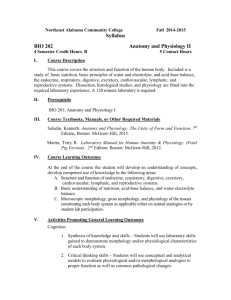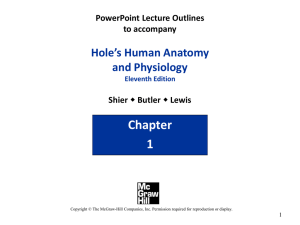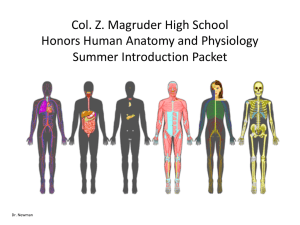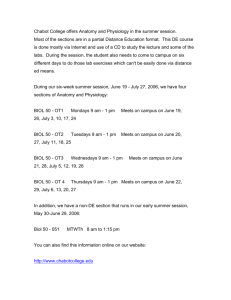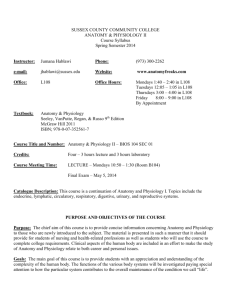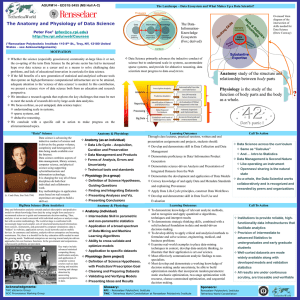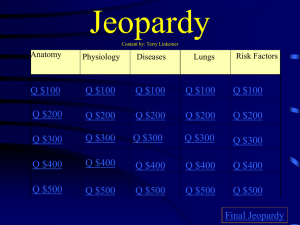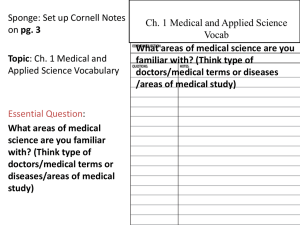COURSE OUTLINE FOR LECTURES AND LABS
advertisement
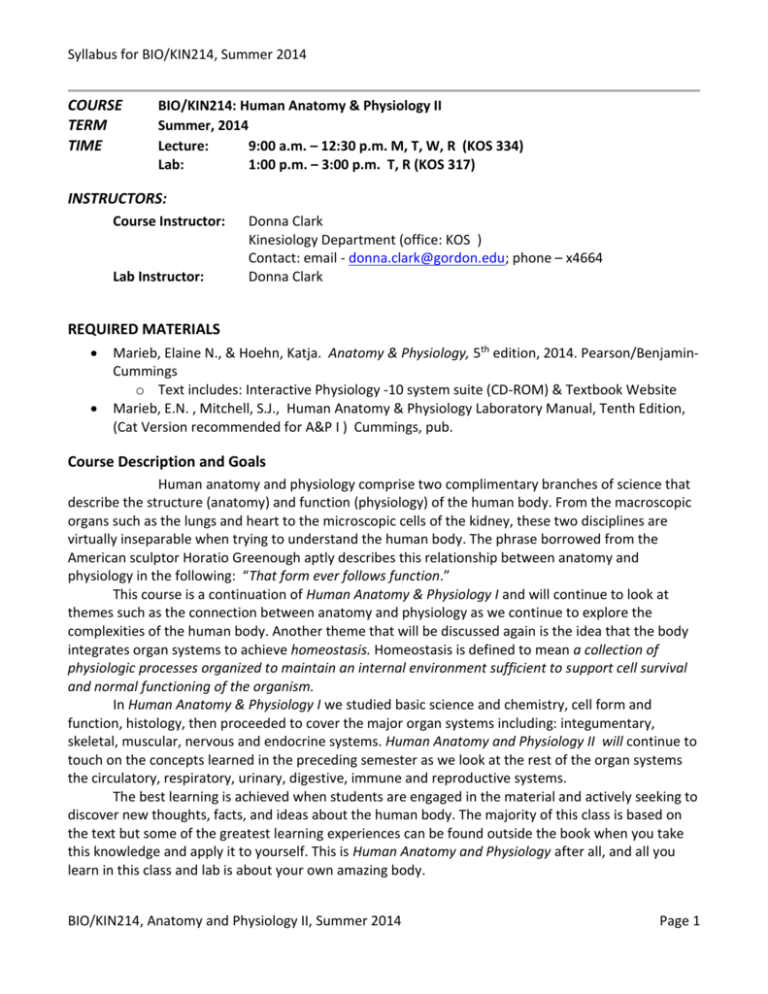
Syllabus for BIO/KIN214, Summer 2014 COURSE TERM TIME BIO/KIN214: Human Anatomy & Physiology II Summer, 2014 Lecture: 9:00 a.m. – 12:30 p.m. M, T, W, R (KOS 334) Lab: 1:00 p.m. – 3:00 p.m. T, R (KOS 317) INSTRUCTORS: Course Instructor: Lab Instructor: Donna Clark Kinesiology Department (office: KOS ) Contact: email - donna.clark@gordon.edu; phone – x4664 Donna Clark REQUIRED MATERIALS Marieb, Elaine N., & Hoehn, Katja. Anatomy & Physiology, 5th edition, 2014. Pearson/BenjaminCummings o Text includes: Interactive Physiology -10 system suite (CD-ROM) & Textbook Website Marieb, E.N. , Mitchell, S.J., Human Anatomy & Physiology Laboratory Manual, Tenth Edition, (Cat Version recommended for A&P I ) Cummings, pub. Course Description and Goals Human anatomy and physiology comprise two complimentary branches of science that describe the structure (anatomy) and function (physiology) of the human body. From the macroscopic organs such as the lungs and heart to the microscopic cells of the kidney, these two disciplines are virtually inseparable when trying to understand the human body. The phrase borrowed from the American sculptor Horatio Greenough aptly describes this relationship between anatomy and physiology in the following: “That form ever follows function.” This course is a continuation of Human Anatomy & Physiology I and will continue to look at themes such as the connection between anatomy and physiology as we continue to explore the complexities of the human body. Another theme that will be discussed again is the idea that the body integrates organ systems to achieve homeostasis. Homeostasis is defined to mean a collection of physiologic processes organized to maintain an internal environment sufficient to support cell survival and normal functioning of the organism. In Human Anatomy & Physiology I we studied basic science and chemistry, cell form and function, histology, then proceeded to cover the major organ systems including: integumentary, skeletal, muscular, nervous and endocrine systems. Human Anatomy and Physiology II will continue to touch on the concepts learned in the preceding semester as we look at the rest of the organ systems the circulatory, respiratory, urinary, digestive, immune and reproductive systems. The best learning is achieved when students are engaged in the material and actively seeking to discover new thoughts, facts, and ideas about the human body. The majority of this class is based on the text but some of the greatest learning experiences can be found outside the book when you take this knowledge and apply it to yourself. This is Human Anatomy and Physiology after all, and all you learn in this class and lab is about your own amazing body. BIO/KIN214, Anatomy and Physiology II, Summer 2014 Page 1 Syllabus for BIO/KIN214, Summer 2014 Students can further help to retain the information by taking yourself through a verbal exercise to “tell the story” of how a particular body system normally functions and is integrated with other systems to maintain homeostasis. Also consider how these systems, collectively, function to meet challenges to homeostasis when the body encounters conditions such as disease, exercise and changes in the environment. The purpose of this course is to help students learn and understand human anatomy and physiology. Beyond that admirable goal is the true purpose of this class and all of our lives to glorify God in all that we do. May we praise Him for His incredible design and use this knowledge to further His Kingdom and become more like Him. The goals of this course are as follows: To develop an appreciation for the wondrous complexity of the human body. To develop a knowledge base of human anatomy and physiology so that students may o acquire terminology used to describe the body’s structure and organization o understand the major anatomical structures of the body’s organ systems o understand the complimentary nature of structure and function o understand the function and interrelationships of the body’s organ systems o acquire a level of knowledge sufficient for future schooling and career training To give students the opportunity to share their knowledge with others To give students the chance to evaluate how you treat and use their bodies and how to better serve and glorify God. COURSE PROCEDURES 1. Students are expected to attend all lectures and laboratory sessions. 2. All required reading for lectures and labs are to be completed prior to the assigned period. 3. If notice is given in advance, a make up of an exam or quiz missed due to an excused absence may be scheduled at the discretion of the instructor. Students should refer to the Student Handbook for a definition of an excused absence. 4. Policy for Students with Disabilities Gordon College is committed to assisting students with documented disabilities (see Academic Catalog Appendix C, for documentation guidelines). A student with a disability who may need academic accommodations should follow the procedure described below: Meet with a staff person from the Academic Support Center (Jenks 412, x4746) to: o make sure documentation of your disability is on file in the ASC, o discuss the accommodations for which you are eligible, o discuss the procedures for obtaining the accommodations, and o obtain a Faculty Notification Form. Deliver a Faculty Notification Form to each course professor within the first full week of the semester; at that time make an appointment to discuss your needs with each professor. Failure to register in time with your professor and the ASC may compromise our ability to provide the accommodations. Questions or disputes about accommodations should be immediately referred to the Academic Support Center. See Grievance Procedures available from the ASC. BIO/KIN214, Anatomy and Physiology II, Summer 2014 Page 2 Syllabus for BIO/KIN214, Summer 2014 STUDENT EVALUATION The course grade is based on the following items: (a) a lab grade determined by laboratory exams, attendance, reports, lab assignments, and lab quizzes, (b) four content exams covering lecture material primarily, (c) lecture quizzes, and (d) a short integration paper. EVALUATION ITEM % weighting of Final Grade Laboratory Grade Lab Exams (2): 75% of lab grade Quizzes: 25% Quizzes cover lab manual and class lecture material relevant to upcoming lab or previously completed labs; direction will be given each day in class period. Content Exams 40% 60% Content Exams (3): Weighted equally – Each is 20% of the final grade. GRADE A A- B+ B B- C+ C CRITERIA 4.0 93% + Work indicating superior mastery of the material. Content, concepts, or Excellent techniques are applied with exceptional skill or great originality in satisfying the requirements of an assignment or course. Outstanding presentation of work, with no errors. 3.7 90Work indicating a mastery of material. Thorough knowledge of concepts and/or 92% techniques together with a high degree of skill and/or some elements of originality in satisfying the requirements of an assignment or course. Superior presentation with no significant errors or misconceptions. 3.3 87Thorough knowledge of concepts and/or techniques together with a fairly high 89% degree of skill in applying them to satisfy the requirements of an assignment or course. Very good presentation of work with no more than a trivial error or misconception. 3.0 83Fine level of knowledge of concepts and/or techniques together with 86% Good considerable skill in using them to satisfy requirements of an assignment or course. Good presentation of work with infrequent, minor misconceptions or errors in interpretation. 2.7 80Acceptable or adequate level of knowledge of concepts and/or techniques 82% together with considerable skill in using them to satisfy requirements of an assignment or course. Adequate presentation of work, with sporadic minor errors or misconceptions. 2.3 77Acceptable level of knowledge of concepts and/or techniques with some skill in 79% using them to satisfy requirements of an assignment or course. Limited ability in understanding and/or applying the material. “Sloppy” or careless presentation of work with minor errors throughout and several misconceptions or errors in interpretation. 2.0 73-76% Acceptable level of knowledge of concepts and/or techniques with minimum Satisfactory skill in using them to satisfy requirements of an assignment or course. Limited ability in understanding and/or applying the material. Poor presentation of work with errors throughout or some of the information is seriously misinterpreted. BIO/KIN214, Anatomy and Physiology II, Summer 2014 Page 3 Syllabus for BIO/KIN214, Summer 2014 C/D 1.7/1.0 6072% Not Meeting Criteria 0 59% & below Fail, no credit F Minimal knowledge of concepts and/or techniques needed to satisfy the requirements of an assignment or course. Work demonstrates a less than adequate grasp of the material, incorrect interpretation, and very poor presentation throughout. May be asked to redo assignment. Incomplete assignment and/or considerable error in work done. Incongruities in interpretation reflecting poor grasp of material. Poor presentation throughout. Inadequate participation/attendance of laboratory and class periods. COURSE OUTLINE FOR LECTURES AND LABS (Marieb, 5th Edition) Text Reading Day 1 M 06/16 Class overview/Introduction to Hormones Syllabus … Ch. 15: Endocrine System The Nature of Hormones 519-525 Pituitary/Hypothalamic Axis 525-533 Thyroid 533-537 Day 2 T T Text Reading 06/17 Lab 1: Ch. 15 Endocrine System Parathyroid 537-539 The Adrenal Gland 539-544 Pineal and other endocrine glands 544-550 LAB EXERCISE 27: ENDOCRINE/HORMONES - Lab overview, expectations, ETC LAB EXERCISE 29: BLOOD Day 3 W 06/18 Text Reading Ch. 16 Blood Blood Composition and Functions 552-553 Plasma and Formed Elements 553-566 Hemostasis 566-571 Transfusion and Blood Replacement in Lab 571-574 Day 4 R 06/19 Text Reading Ch. 17: The Heart General anatomy (quick overview … lab thoroughly does this) 576-588 Cardiac Muscle 588-591 BIO/KIN214, Anatomy and Physiology II, Summer 2014 Page 4 Syllabus for BIO/KIN214, Summer 2014 R Lab 2: Heart Physiology 591-603 LAB EXERCISE 30: HEART ANATOMY Dissections Day 5 Text Reading M 06/23 Cardiology surgical videos EXAM 1: Endocrine System, Blood, and The Heart Ch. 18: Blood Vessels and Circulatory Physiology Blood Vessel Structure and Function 605-612 Circulatory Pathways 631 Day 6 T Text Reading 06/24 Ch. 18: Blood Vessels and Circulatory Physiology T Lab 3: Physiology of Circulation Part I 612-630 Lab Exam 1: See images packet Heart Anatomy II coronary circuit (vessels) and prevention of CVD Day 7 Text Reading W 06/25 Ch. 19: The Lymphatic System Ch. 21: The Respiratory System Day 8 656-664 700-714 Text Reading R 06/26 Ch. 21: The Respiratory System Mechanics of Breathing 714-721 Gas Exchange 721-725 Exam Review R Lab 4: LAB EXERCISES 36 & 37 & Respiratory Dissection Day 9 M 06/30 Exam 2: Blood Vessels, Circulatory Physiology, Lymphatics Ch. 21: The Respiratory System Gas Transport in the Body 725-730 Respiratory Control I 731-735 Altitude and Exercise 735-736 Disease 736-738 BIO/KIN214, Anatomy and Physiology II, Summer 2014 Page 5 Syllabus for BIO/KIN214, Summer 2014 Day 10 T Text Reading 07/01 T Lab 5: Ch. 22 Digestive System Overview & Functional Anatomy: Mouth 741-754 Digestive Process: Mouth to Esophagus 754-756 Digestive Process: Stomach to Large Intestine 756-766 Physiology of Digestion 782-790 NUTRITION LECTURE LAB EXERCISE 38 : DIGESTIVE SYSTEM- Dissection Day 11 W 07/02 Text Reading Ch. 23: Metabolism Overview of Metabolic Processes 799-802 Metabolism of Major Nutrients 802-815 Day 12 R 07/03 Text Reading Ch. 23: Metabolism Metabolism of Major Nutrients (continued) 802-815 The Liver and Cholesterol 821-824 Metabolic Rate and Heat Production 827-828 Temperature Regulation 828-832 Day 13 M 07/07 Text Reading Ch. 24: The Urinary System Overview 834-842 842-857 Kidney Physiology Exam Review Day 14 T T 07/08 Lab 6: Text Reading Exam 3 Respiration, Digestion, Metabolism, Thermal Regulation Ch. 24: The Urinary System Kidney Physiology (continued) 842-857 LAB EXERCISES 40 & 41 – Urinary System Dissection BIO/KIN214, Anatomy and Physiology II, Summer 2014 Page 6 Syllabus for BIO/KIN214, Summer 2014 Day 15 W 07/09 Text Reading Ch. 24: The Urinary System Clinical Evaluation of Kidney Function 857-858 859-863 Urine Transport, Storage, and Elimination Ch. 26: Reproductive Physiology Anatomy of the Male Reproductive System 887-894 895-903 Physiology of the Male Reproductive System Day 16 R 07/10 R Lab 7: Text Reading Ch. 25: Reproductive Physiology Anatomy of the Female Reproductive System 903-911 Physiology of the Female Reproductive System 911-921 Sexually Transmitted Infections 921-922 Exam 2: See images packet BIO/KIN214, Anatomy and Physiology II, Summer 2014 Page 7

